Snapdragon 800 (MSM8974) Performance Preview: Qualcomm Mobile Development Tablet Tested
by Brian Klug on June 18, 2013 8:00 PM EST3DMark
3DMark for Android features the Ice Storm benchmark and uses OpenGL ES 2.0. Ice Storm is divided into two graphics tests and a physics test. The first graphics test is geometry heavy while the second test is more pixel shader intensive. The physics test, as you might guess, is CPU bound and multithreaded. The overall score takes into account both graphics and physics tests. The benchmark is rendered to an offscreen buffer at 720p/1080p and then scaled up to the native resolution of the device being tested. This is a very similar approach we've seen by game developers to avoid rendering at native resolution on some of the ultra high resolution tablets. The beauty of 3DMark's approach here is the fact that all results are comparable, regardless of a device's native resolution. The downside is we don't get a good idea of how some of the ultra high resolution tablets would behave with these workloads running at their native (> 1080p) resolutions.
For these benchmarks we stuck with the default presets (720p, normal quality).
Here the key comparisons are against the Adreno 320 based HTC One/SGS4 (T-Mobile) and the PowerVR SGX 544MP3 based SGS4 (SHEVE300S). The Nexus 10 is interesting but pretty much a blowout. Snapdragon 800 is clearly the new high-end Android tablet SoC of choice.
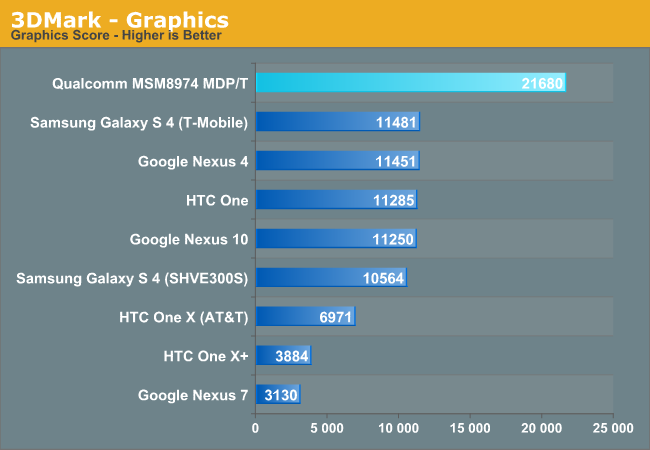
The overall graphics score from Adreno is amazing. We're looking at almost 2x the next fastest contender here, the Adreno 320 based Snapdragon 600.
Graphics Test 1
Ice Storm Graphics test 1 stresses the hardware’s ability to process lots of vertices while keeping the pixel load relatively light. Hardware on this level may have dedicated capacity for separate vertex and pixel processing. Stressing both capacities individually reveals the hardware’s limitations in both aspects.
In an average frame, 530,000 vertices are processed leading to 180,000 triangles rasterized either to the shadow map or to the screen. At the same time, 4.7 million pixels are processed per frame.
Pixel load is kept low by excluding expensive post processing steps, and by not rendering particle effects.
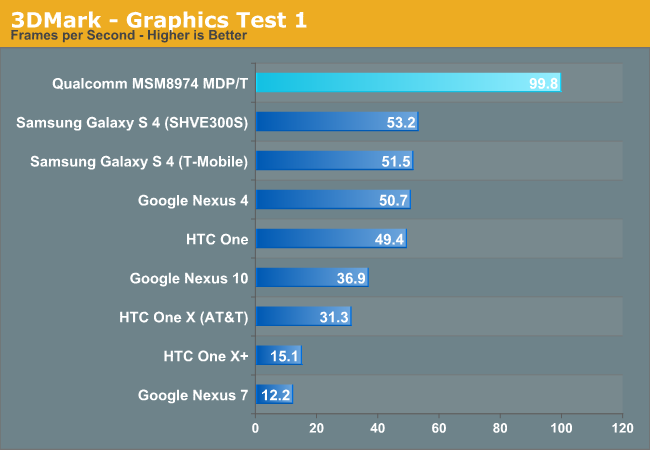
Graphics Test 2
Graphics test 2 stresses the hardware’s ability to process lots of pixels. It tests the ability to read textures, do per pixel computations and write to render targets.
On average, 12.6 million pixels are processed per frame. The additional pixel processing compared to Graphics test 1 comes from including particles and post processing effects such as bloom, streaks and motion blur.
In each frame, an average 75,000 vertices are processed. This number is considerably lower than in Graphics test 1 because shadows are not drawn and the processed geometry has a lower number of polygons.
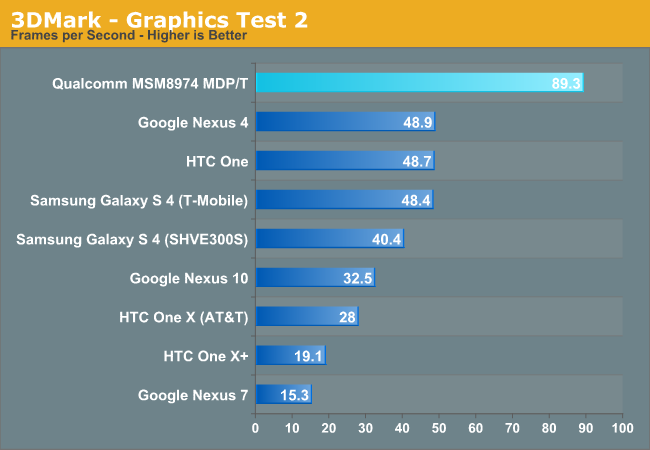
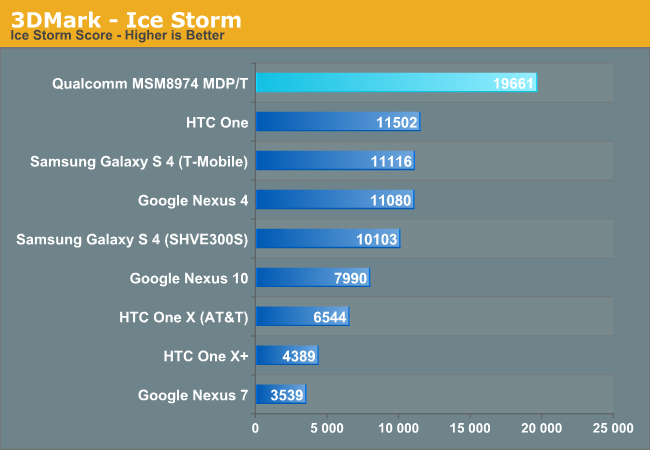
The overall Ice Storm score shows a 71% improvement over Snapdragon 600, which is the closest competitor.
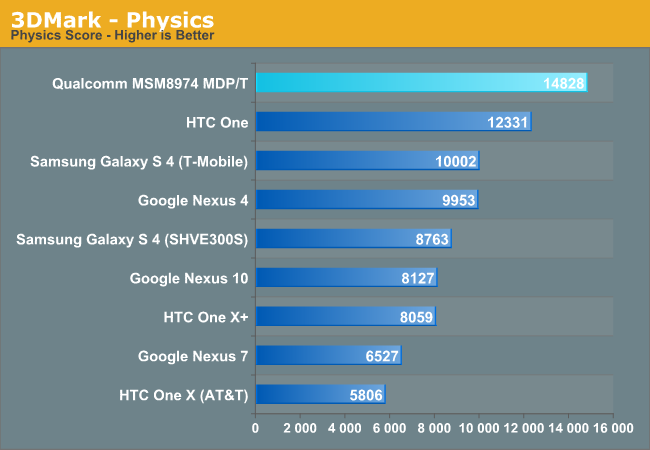
The physics test takes multicore CPU performance into account, but even then the Snapdragon 800 remains ahead of the pack. The performance advantage over the lower clocked Snapdragon 600 shrinks to just 20%, which is a bit lower than clock speeds alone would normally tell us.
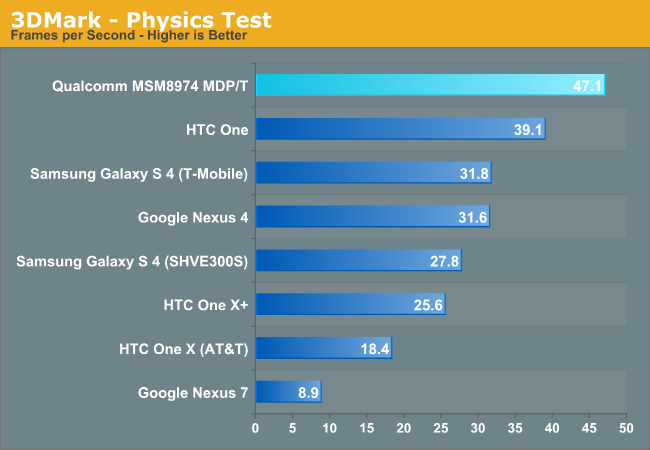










115 Comments
View All Comments
Kurge - Wednesday, June 19, 2013 - link
Yeah.. no. Saltwell is a 2 core, in-order processor.Silvermont is a completely different beast - 4 real, out of order cores.
I _do_ expect Silvermont to come close to A15 and in fact go well beyond.
Wilco1 - Wednesday, June 19, 2013 - link
Why would you expect that? Silvermont is just a 2-way limited OoO core, very similar to Cortex-A9. Cortex-A15 on the other hand is very aggressive with a large reordering window, 3-way and supports 2 memory accesses per cycle (vs just 1 for SilverMont). Given that it should be obvious Silvermont will have a lower IPC than Cortex-A15.You'll be disappointed. Even Intel is claiming just a 2.8 speedup with double the cores and a 20% clock boost. So at the same core count and frequency the speedup from Silvermont is only 16%...
ncp - Wednesday, June 19, 2013 - link
Qualcomm will probably keep the power low as they are cheating on benchmarks.They are detecting what application is launched. For a given list of benchmarks they are tweaking CPU governor to go to full power, tweak data base access and anything yet uncovered.
This way they got very competitive scores on known benchmarks.
This is somewhat smart, however other competitor (IC maker) don't do that so get scores more inline with the way the device is configured in order to get a good pert/power compromise.
Some phone makers are also cheating on top of Qualcomm Cheating, at least one.
Note that probably many phone makers using Qualcomm chipset even do not realize they are cheating on behalf of Qualcomm.
krumme - Wednesday, June 19, 2013 - link
Does that include the "at least one" cheating on top of Qualcomm?Wilco1 - Wednesday, June 19, 2013 - link
In what way is setting the CPU governor cheating? You won't get a better score than the maximum possible score, you'll just get it first time. It seems there is far worse cheating going on with eg. Atoms AnTuTu scores, which are impossibly high (A15 has 3 times faster Stream scores and yet less than half the memory score in AnTuTu?!?).qwerty12345 - Friday, June 21, 2013 - link
looks like wilco1 is a paid pro-qcomm and anti-intc talking machineLaststop311 - Wednesday, June 19, 2013 - link
oh man once we hit 14nm soc arm designs we are gonna have insane performance.FramePointer - Wednesday, June 19, 2013 - link
You're naive if you believe you can accurately estimate the performance of Silvermont based on high level architectural details like the ones you have provided. Given how the current generation of Atom is still using in order execution it should be no match to Qualcomm's Krait or even a basic Cortex A9 (which has at least limited OOO execution) if we were using your logic. Anandtech's own analysis has shown that this is not the case at all."Silvermont is just a 2-way limited OoO core, very similar to Cortex-A9. "
And yet even Clovertrail+ crushes the ARM A9 and it is older than Silvermont.
Wilco1 - Thursday, June 20, 2013 - link
Yes you can make accurate predictions based on the microarchitecture, I've got the experience and patents to make that statement. A9 typically crushes much higher clocked Atoms, eg. http://browser.primatelabs.com/geekbench2/compare/... Both are 4 threads btw, so it is a fair comparison, however a 1.6GHz A9 beats a 2GHz Atom on most single threaded benchmarks as well. Again this is entirely expected based on their respective microarchitectures.Anand's analysis is not believable given he only ever runs JavaScript benchmarks, and these are highly dependent on the browser used. Even on the same hardware there are huge variations. To give an example, the S4 Octa scores 679 on SunSpider according to FoneArena, but Anand claims 920 above. That's a huge difference on the same phone - who is right? The 679 number is correct as that is close to what the Exynos 5250 scores in the Chromebook. So until Anand cleans up his benchmarking I would take his scores with a bag of salt.
shodanshok - Thursday, June 20, 2013 - link
If you think that a single A9 core can beat and destroy a single Atom core, you are wrong.From Anand's iPad2 review:
Alongside multitasking is the performance problem. With the original iPad even deleting several emails at a time was a bit choppy, and web page rendering performance needed tons of work. As always Apple does its best to hide the limitations of the platform but I must point out that even the iPad 2 with a pair of ARM Cortex A9s has lower CPU performance than a netbook with a single core Atom. The fact that you can't really tell most of the time is a testament to Apple's software engineering, but it doesn't change reality.
Some more benchmark:
Tegra 250 @ 1.0 GHz
Core: 2
Compiler: GCC 4.4.5
Coremark/MHz: 5,148
Total Score: 5148,01
Threads: 4
Flags: -O3 -funroll-loop -falign=8 -mcpu=cortex-a9 -mfpu=vfpv3-d16 -mfloat-abi=soft
Atom N280 @ 1.68 GHz
Core: 1
Compiler: GCC 4.4.4
Coremark/MHz: 3,187
Total Score: 5353,79
As you can see, _2_ A9 cores nave total throughput equal to a single Atom core. Atom need high clock of curse, bit it was a specific architectural choice from the start.
The truth is that only A15 decisively defeat Atom.
Unfortunely, Atom GPU was really terrible, being crushed by all others.